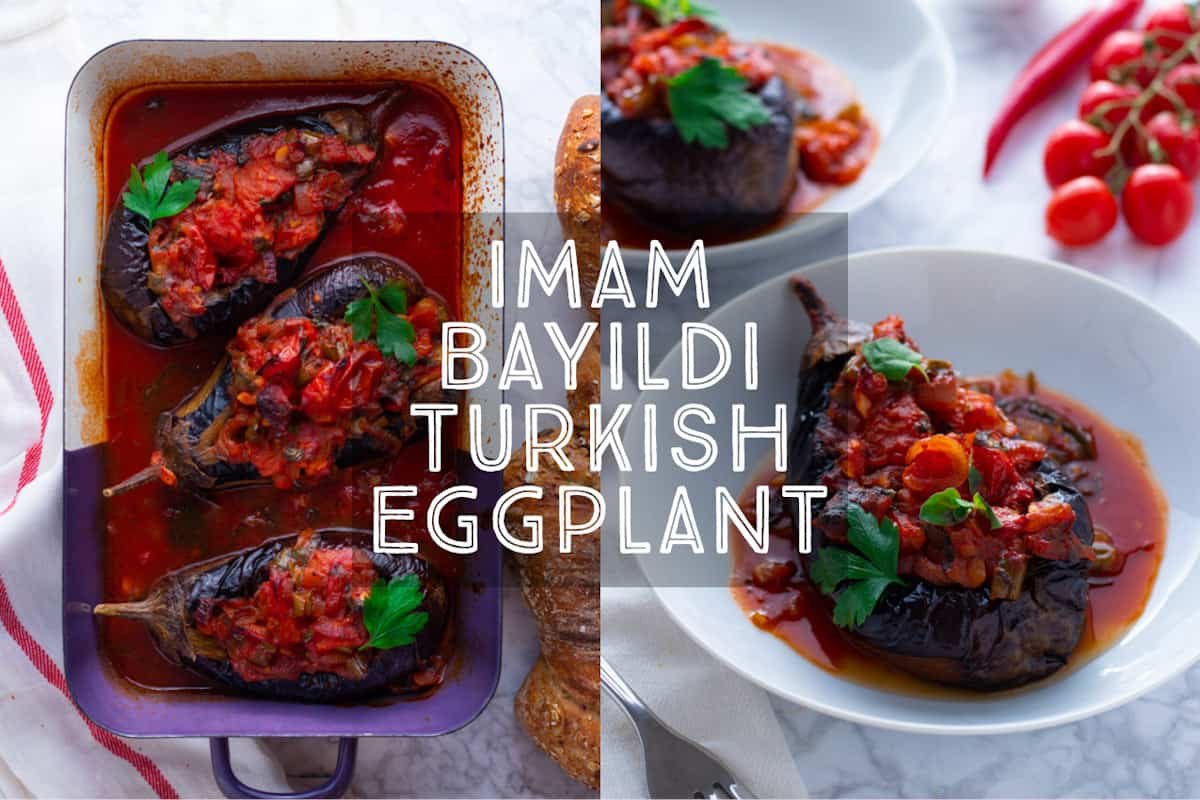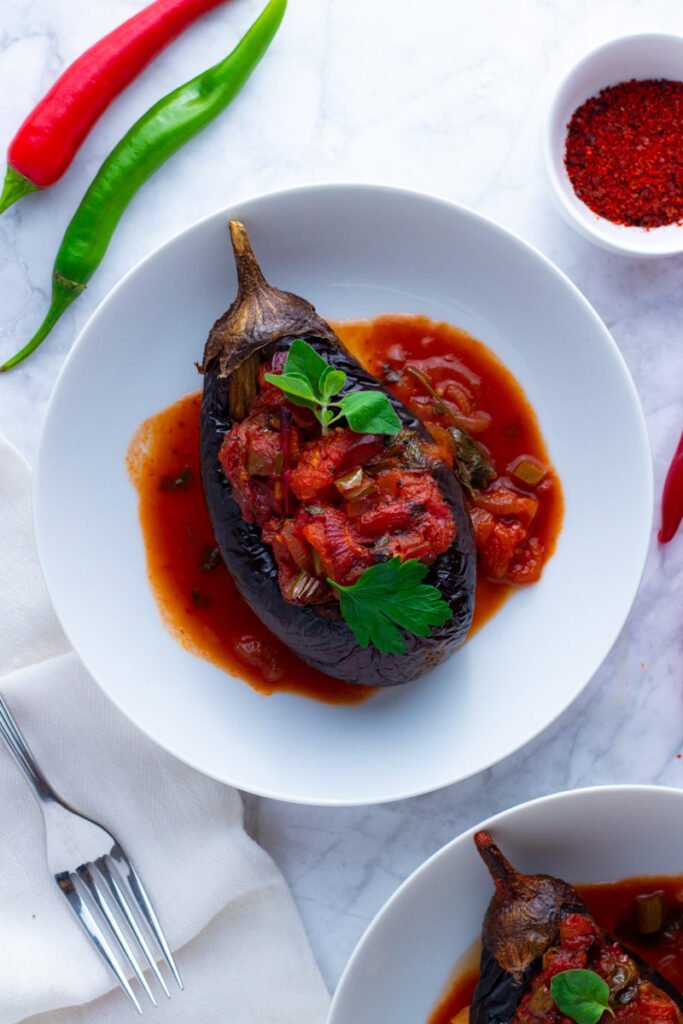

Imam Bayildi
Made from meltingly tender roasted eggplants, stuffed with a spicy tomato sauce and lashings of olive oil, İmam bayıldı or ‘the Imam fainted’ is one of the most famous of all Turkish dishes.
Ottoman and Turkish cuisine must have a million and one wonderful recipes for eggplants, each more delicious than the last. One of the best known (and tastiest!) is İmam bayıldı (literally: the Imam fainted).
This popular dish is a fabulous vegetarian meal, made from eggplants, tomatoes, onions and plenty of olive oil. This classic combination of ingredients produces an incredibly delicious feast, with the slow cooking time making the eggplant meltingly tender.

I’ve been making this tasty recipe ever since I discovered it while living in Cyprus and it is one of my favourite ways of cooking fresh summer produce.
What is İmam bayıldı?
Imam bayildi is made from eggplants which are roasted until tender, then split open and stuffed with a spicy tomato mixture. It is often served at room temperature or even cold as part of a mezze.
Unlike the similar dish Karnıyarık (split belly) which contains meat, imam bayildi is a completely vegetarian recipe.
The story of İmam bayıldı
İmam bayıldı (pronounced ‘ee-mahm ba-yuhl-duh’) means ‘The Imam (Muslim priest) fainted’ in the Turkish language. It is one of the most famous dishes of the Ottoman Empire and can be found in kitchens and restaurants throughout the Mediterranean and Levant.
There are loads of folk stories about how this dish got such an interesting name, though nobody can say for sure which one is true.




In one story the Turkish imam’s new bride (the daughter of an olive oil merchant) cooks him this delicious eggplant dish night after night, until she has used up all the expensive olive oil that she brought with her into the marriage.
On learning that there is no more olive oil left, the imam faints with shock. In another, the imam simply faints in pleasure at the heavenly taste of this dish.
In all the stories, the imam falls in love with the delicious flavours of these stuffed aubergines, and I think you will too.
Ingredients
To make this classic Turkish recipe, you’ll need the following main ingredients:
- Eggplants / Aubergines: traditionally this dish would be made with the long, skinny eggplants typically grown in Turkey and the Middle East. If you can only get the more rounded variety, try to choose some small eggplants for the best results.
- Chopped tomatoes and onions: Use the juiciest, ripest tomatoes you can find. I like to add some tomato passata to bump up the tomatoey flavour.
- Green chilli peppers: Look out for the long, mild type. If you have a Turkish or Arab food market near to you, head along and check out their fresh produce.
- Oregano, chopped parsley and pul biber: Turkish food makes full use of fresh herbs, so be generous. Pul Biber, sometimes known as Aleppo pepper is a lovely, mild flaked red pepper.
- Olive oil: The star of the show! As with many recipes from the Turkish and Arab world, it’s important to use a generous amount of olive oil when making this dish.

Instructions
There are three main steps to making this dish:
- First, peel strips off the eggplants, poke plenty of holes in them with a fork, and then roast them until the flesh is tender.
- While the eggplants are cooking, make the stuffing by gently cooking onions, peppers, garlic and chopped tomatoes until soft.
- Last, transfer the eggplants to a baking dish, split them open, stuff them with the tomato mixture and roast until piping hot.
The complete ingredient list and detailed instructions are in the recipe card at the bottom of the page.
What to serve with imam bayıldı?
Because I like to use lots of chilli peppers in my cooking, I always serve imam bayildi with a big bowl of cooling Cacik – that’s a yogurt and cucumber sauce similar to tzatziki – you can get the recipe here.
Turkish food and hospitality are all about generosity and plenty, so a dish like this might be served as part of a much larger feast.
You could serve it alongside another Turkish dish like Chicken and Chickpea Pilaf, with Turkish Chicken Shish Kebabs, Köfte or Börek. As a side dish, you could serve a Turkish or Greek Salad or a Turkish Bulgur salad.
For dessert, I’d recommend a big tray of nutty Baklava or sweet Revani.


Variations
Adding chickpeas to the stuffing mixture is a wonderful way to add even more body to this dish and to make it even more filling. I also like to sprinkle over a little feta cheese and toasted pine nuts to make this special dish even tastier.
FREQUENTLY ASKED QUESTIONS
Do I have to use so much olive oil?
I’ve actually dialled the amount of olive oil in this dish back a little bit from the traditional recipes (I think the imam would probably approve!). The olive oil is an important part of this recipe, however, you can reduce it a little if you’d like.
Can I prepare Imam Bayildi in advance?
Yes! This is a fantastic dish to make in advance, in fact, I find it is even tastier the second or third time it is heated through!
Can I freeze Imam Bayildi?
Yes, it will keep in the freezer for several months.


Do I need to salt my eggplant?
Many traditional recipes call for salting or soaking eggplants in salted water to draw out the bitterness. Like many fruit and vegetables grown today, modern varieties of eggplant have had the bitterness bred out of them, meaning you can safely skip this step.

İmam bayıldı Turkish Recipe

İmam bayıldı (Turkish Stuffed Eggplants)
Made from meltingly tender roasted eggplants, stuffed with a spicy tomato sauce and lashings of olive oil, İmam bayıldı or ‘the Imam fainted’ is one of the most famous of all Turkish dishes.
Did the Imam faint because the olive oil was so expensive? Or because this dish was so tasty? Try it and see for yourself!
Did the Imam faint because the olive oil was so expensive? Or because this dish was so tasty? Try it and see for yourself!
Ingredients
- 4 long eggplants, see notes
- 3 Tbsp extra virgin olive oil
for the tomato stuffing:
- 3 Tbsp extra virgin olive oil
- 1 Tbsp unsalted butter
- 2 red onions. halved and sliced
- 1 long green pepper, diced
- 4 medium tomatoes, roughly chopped
- 3 large cloves of garlic
- 125 ml tomato passata (puréed tomatoes)
- 2 tsp dried oregano
- 1 tsp sugar
- 1 tsp sweet Pul Biber, mild red pepper flakes
- bunch fresh parsley, chopped
- 1 ½ Tbsp tomato paste
- sea salt and black pepper
- extra olive oil for drizzling
Instructions
- PREPARE: Heat the oven to 200°C / 400°F / Gas mark 6. Use a vegetable peeler or small, sharp knife to peel the eggplants in wide strips (like a zebra!).
- ROAST THE EGGPLANTS: Poke plenty of holes into the eggplants with a fork, then brush generously with the oil. Place on a rack set over an oven tray and roast in the preheated oven for 30-40 minutes, until tender.
- MAKE THE STUFFING: While the eggplants are roasting, heat the olive oil and butter in a frying pan. Gently cook the onion and pepper for 5 minutes until beginning to soften. Add the tomatoes and garlic to the pan and cook for 5 minutes, using a wooden spoon to break up the tomatoes gently.
- FLAVOUR THE SAUCE: Add the passata, oregano, sugar, pul biber and half the parsley to the pan, season generously with salt and pepper and cook for a further 5-10 minutes until reduced and thickened.
- STUFF THE EGGPLANTS: When the eggplants are cooked and soft, remove them from the oven and place them in an oven-proof casserole dish. Cut a long slit down the length of each eggplant, then use two forks to pull apart the sides and to mash the soft eggplant flesh a little. Divide the tomato filling between the eggplants. If there is any leftover, spoon it into the dish.
- ROAST THE STUFFED EGGPLANTS: Stir the tomato paste together with 250ml (1 cup) of warm water and pour over and around the eggplants. Drizzle over a generous amount of olive oil, then return to the oven for a further 45 minutes.
- SERVE: Serve warm or at room temperature, garnished with the remaining parsley and a squeeze of lemon juice.
Notes
Try to seek out long, thin, Middle Eastern style eggplants if possible. Otherwise choose smaller eggplants for best results.
Pul biber, sometimes known as Aleppo pepper, is used extensively in Turkish and Cypriot cooking. These pepper flakes have a lightly smoky flavour and a beautiful deep red colour. Try picking them up in a Turkish or Middle Eastern shop, or order online. They vary in heat from mild (Tatli) to very, very hot (çok çok acı), so be careful which ones you buy!
Recommended Equipment
As an Amazon Associate and member of other affiliate programs, I earn from qualifying purchases.
Nutrition
Serving: 1stuffed eggplant | Calories: 289kcal | Carbohydrates: 17g | Protein: 3g | Fat: 25g | Saturated Fat: 5g | Polyunsaturated Fat: 3g | Monounsaturated Fat: 16g | Trans Fat: 0.1g | Cholesterol: 8mg | Sodium: 68mg | Potassium: 641mg | Fiber: 4g | Sugar: 10g | Vitamin A: 1486IU | Vitamin C: 50mg | Calcium: 41mg | Iron: 1mg
Tried this recipe?Leave a review or a star rating and let me know how it was! Use the hashtag #daysofjay on Instagram so I can see your delicious creations.
If you enjoyed this recipe, please leave a star rating in the recipe card and share it using the buttons below so that others can find it too!







I have been in Turkey/Greece/MiddleeastAfrica in many occasions. the best food that i had cooked in Turkey to be honest. Most Greek nationalists are trying to claim Turkish dishes on their name. Such as Yoğurt comes from Sumerian era in Mezepotemia, coffee comes from Yemen(was Ottoman land), baklava, pirzola, kofte, cacik, kokareç, chicken soup and many others tried to named after Greek name inorder to brand for themselves. Butshould have been brand as Style (greek style/moroccon style/thai style/turkish style etc….